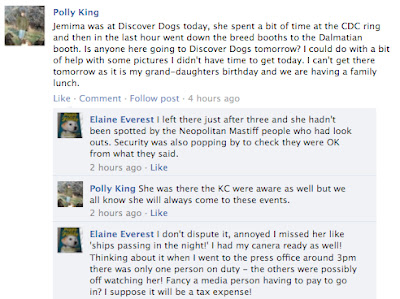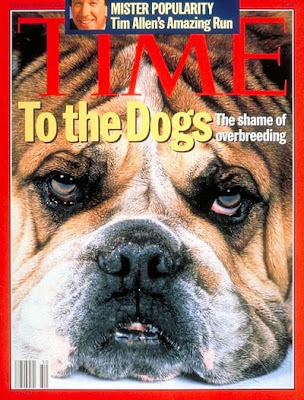 |
| From the "Stop the BBC Making Another PDE" Facebook site this eve... |
The "
Stop the BBC Making Another PDE" Facebook site issued several dire warnings in the past week warning good dog folk to be on their guard at this weekend's
Discover Dogs against "JH" taking pictures without permisson. Their cunning plan? To take photographs of me or anyone who might conceivably be an agent of mine.
That would, then, be pictures taken without permission. The irony appeared to be somewhat lost on them.
In fact, the Kennel Club had refused us access to film so we couldn't. No ifs or buts - BBC rules are strict on this and secret filming is only allowed in special circumstances. There was nothing to stop us filming outside, though, so we set up camp outside to ask visitors about their breed choice; then I paid for a ticket to have a quick whizz round the show in the last hour; camera switched off and firmly zipped in the camera bag.
Don't think the KC trusted me to keep it zipped though. As I stopped to have a chat with Sarah Blott from the Animal Health Trust at the
Cavalier Matters stand, the KC's Caroline Kisko and Bill Lambert approached and hovered. Bill then followed me as I wended my way towards the exit, quite literally ducking behind breed stands to try to avoid being seen; at one point peering through a gap in one stand's dressing to keep me in sight. Very Keystone Cops.
I doubled-back and collared him, telling him he should feel free to say hello. I also thanked him for the information he had sent me last week in response to questions about the
Assured Breeder Scheme. "I look forward to seeing how negatively you use that information," said Bill.
"Well," I replied, "I am a bit surprised to learn that the KC has inspected only
15 per cent of the breeders who have joined the Assured Breeder Scheme."
I mean, really, and with the best will in the world, it is
quite hard to put a positive spin on that, isn't it?
On the plus side, Bill also told me that all breeders who have registered more than two litters in the previous 12 months are now inspected before they are accepted and that there are plans to extend this to all applicants (although he couldn't say when).
But if (as is the case) the KC has only done 1100 odd inspections in total since the scheme started in 2004 and they only have 23 breeder advisors (compared, for instance, to over 100 in Sweden where in 2010 alone they did 2000 breeder visits), when exactly is the KC going to get round the 6,000 or so ABS breeders who have never been inspected?
There was some good news at Discover Dogs during my brief visit. A breed advisor was honest about the health issues in Boxers on the Boxer breed stand and it was good to see health informaton given real prominence on the Griffon stand, as it was last year. I also saw nothing to stop me lusting after a Hovawart (despite worries about the small gene pool).
But I'm afraid the rep on the Neopolitan Mastiff let the side down when asked if the breed had any health problems. "Not really," came the reply. He also maintained that they lived on average to 8 yrs old (not really his fault - this entirely unsupported claim is in black and white in the health info the Club prepared for Discover Dogs; a bit of a shame because the rest of the health info is not bad).
Finally, despite having lookouts/security in place to protect the Neapolitan Mastiffs from me and prying lenses, this picture was sent to me this evening of the dog on the breed stand this afternoon.
Just to make it crystal clear to Neapolitan Mastiff breeders who will no doubt express outrage: the crime is not in my publishing pictures like this; it's in you breeding dogs like this.
If you don't want pictures of Neopolians with desperate eye conformation, too-narrow nares and sore skin being blogged or broadcast for everyone to wince at...
stop breeding them this way.
Edit 13/11/11 @ 20:04
Now that we know this dog is Rayvonley Leone (see comments), here is a picture of him at Darlington Championship Dog Show a few weeks ago, where he won Best Dog. If you click to enlarge it, you'll see there is no skin irritation under his nose, but his chin looks sore and his eye looks no better than it does in the above picture.
Edit 13/11/11 -
The reaction from the anti-PDE Facebook site....
So now we know. The dogs are just fine. I have, apparently, been photoshopping the images in order to make the dogs look bad.
Which beggars the question: if I could prove that I have not photoshopped them, would they agree that there is a problem that needs to be fixed?









